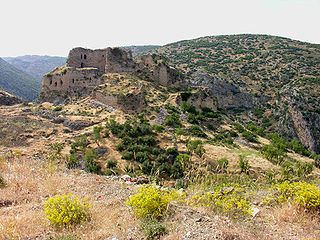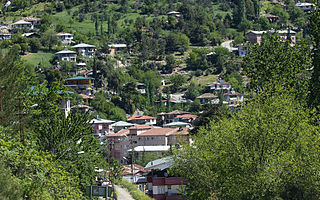| Kozan Castle | |
|---|---|
| Part of Many states | |
| Adana Province, Turkey | |
 From northwest | |
| Coordinates | 37°26′30″N35°48′35″E / 37.44167°N 35.80972°E Coordinates: 37°26′30″N35°48′35″E / 37.44167°N 35.80972°E |
| Type | Fortress |
| Site information | |
| Open to the public | Yes |
| Site history | |
| Demolished | Most of it |
Kozan Castle (Medieval: Sis Castle Turkish : Kozan Kalesi) is a castle in Kozan, Adana Province, Turkey.
The castle is situated on a 400 metres (1,300 ft) high hill at 37°26′30″N35°48′35″E / 37.44167°N 35.80972°E . 130 metres (430 ft) high Kozan city is just to the north of the castle. All nearby castles (like Anavarza Castle and Yılankale) are observable from Kozan castle. [1]
There is no record of fortifications at the site prior to the Byzantine period. [2] In 705 an Arab attack on the town was repelled, but its Christian population later abandoned the settlement and Sis became a fortified frontier post of the Abbasid's. In 962 a Byzantine army under Nikephoros II Phokas recaptured Sis, but nothing is known about its subsequent history until its capture in 1113 by Toros I, ruler of Cilician Armenia. [3] After Kozan was captured by the Armenian Kingdom of Cilicia, the city became its capital after the capital was transferred from Anavarza sometime between 1180-1190.
Almost all of the castle dates from the period of the Armenian kingdom, the main possible exceptions being a vaulted entrance corridor which could be a Mamluk-era (i.e., post 1375) construction and which carries an Arabic inscription, and, beyond this corridor and at the rear of the Armenian-constructed main entrance, a simpler gateway that may have been the original Byzantine entrance to the site. [4]
Inside the castle are the remains of two Armenian chapels - both probably from the 13th century. Both are heavily ruined; one is located in the central spur of the castle, the other inside a semicircular tower in the east wall of the southeast bailey. [5]
The castle consists of two sections in a single outer rampart. There are 44 bastions on the rampart. The inner castle is in the southern section. [1] There are also utility vaults used for storage.
The royal palace of the Armenian kings was a separate fortified structure located just below the castle. It was destroyed in 1375 during the Mamluk siege and capture of Sis. Two corner towers of its donjon remain standing. [6]
















